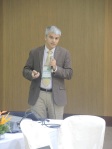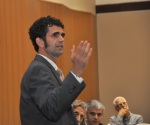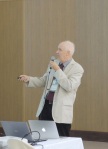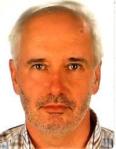Com 231 resumos recebidos, o Simpósio N sobre Engenharia de Superfícies foi o maior do XIII Encontro da SBPMat. Entretanto, como destaquei na abertura do Simpósio, não só a quantidade deve ser avaliada; a qualidade é ainda mais importante. Foi por isso que convidamos palestrantes de peso internacional para dar começo às sessões da segunda e terça-feira. Seguem fotos dos invited em ação: Tiberiu Minea (Paris-Sud), Christopher Muratore (Dayton), Christoph Genzel (HZB) e Amilton Sinatora (USP).
Além disso, houve muita presença internacional nos trabalhos apresentados, dando ares a nosso evento de Simpósio Internacional em Engenharia de Superfícies.
Ainda, os trabalhos apresentados podem ser submetidos por meio do sistema Elsevier a um volume especial da revista Surface & Coatings Technology.
É importante destacar o apoio do INCT Instituto Nacional de Engenharia de Superfícies para custear a vinda dos palestrantes convidados.

Os palestrantes convidados, o coordenador do simpósio (C. Figueroa) e membros do comitê científico (F. Alvarez e F. Lázaro Freire Jr).
Entre outros pontos de destaque, menciono a homogênea distribuição de autores de trabalhos entre as regiões Nordeste, Sul e Sudeste do Brasil. Também chamou a minha atenção a elevada qualidade de alguns trabalhos de iniciação científica (IC), que era superior à de outros trabalhos de doutorado. Não foi casualidade que o prêmio de melhor pôster do Simpósio N foi para um estudante de IC (Rodolfo Bonoto Estevam, da Universidade Estadual de Ponta Grossa, pelo trabalho “Preparation and Characterization Of The Lbl Films Based Nanoparticle Graphene Oxide Interacting With 3-N-Propylpirydinium Silsesquixane Chloride“).
Aguardem nossas novidades para o próximo evento …
Para saber mais sobre o simpósio: http://engenhariadesuperficies.com.br/noticias.asp?idNoticia=442








 Escrito por Carlos A. Figueroa
Escrito por Carlos A. Figueroa 

